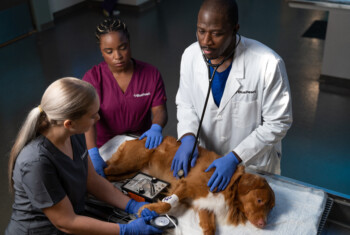Cat Sneezing: Causes and Treatment
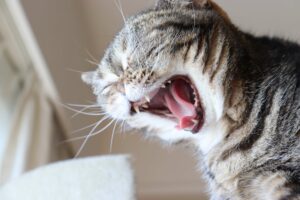 Ah, the cat sneeze – it may be one of the cutest sounds you’ll ever hear, but is it ever a cause for concern? Just like their humans, cats can catch colds and suffer from upper respiratory and sinus infections. However, there are other conditions that can also lead to those cute little sneezes.
Ah, the cat sneeze – it may be one of the cutest sounds you’ll ever hear, but is it ever a cause for concern? Just like their humans, cats can catch colds and suffer from upper respiratory and sinus infections. However, there are other conditions that can also lead to those cute little sneezes.
Why is My Cat Sneezing?
Cats can sneeze for a variety of reasons, such as:
- A simple nose tickle. We’ve all had that!
- A noxious smell, such as chemicals
- Dust and other airborne particles
- A foreign object like a piece of lint, grass or a hair
- A respiratory infection
- Inflammation of nasal cavity and/or sinuses
- Inflammation or infection of a tooth causing drainage into sinuses
Why do Cats Sneeze? Is There a Pattern?
 There’s probably no reason to worry about the occasional sneeze here and there – it may just be something in the air irritating her nasal passage. If it’s more than just occasional, look for patterns: Does it happen around the same time of day? Does it only happen in a certain room or during family activities? Looking for patterns can help determine if your cat is sneezing due to an irritant, such as dust or perfume, or if it’s caused by an infection or other underlying condition.
There’s probably no reason to worry about the occasional sneeze here and there – it may just be something in the air irritating her nasal passage. If it’s more than just occasional, look for patterns: Does it happen around the same time of day? Does it only happen in a certain room or during family activities? Looking for patterns can help determine if your cat is sneezing due to an irritant, such as dust or perfume, or if it’s caused by an infection or other underlying condition.
If you notice your cat sneezes more when you clean the bathroom, or after doing his business in his own bathroom, he could be having a reaction to a chemical in the cleaning products or dust in litter.
On the other hand, if your cat is sneezing a lot and you’ve noticed discharge from the nose or eyes along with a lack of energy and loss of appetite, then it may be something to worry about. Sneezing accompanied by other symptoms could be a sign your cat is suffering from an upper respiratory infection or other underlying condition that may require veterinary care.
When to See a Veterinarian
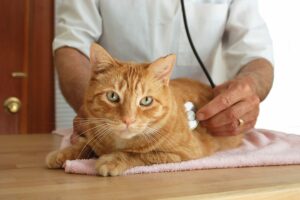 If your cat is only sneezing on occasion with either no other symptoms or very mild symptoms, you may be able to wait a day or two and simply monitor her for any changes. Kittens, on the other hand, should always be seen by a veterinarian when suffering from these types of symptoms.
If your cat is only sneezing on occasion with either no other symptoms or very mild symptoms, you may be able to wait a day or two and simply monitor her for any changes. Kittens, on the other hand, should always be seen by a veterinarian when suffering from these types of symptoms.
If the sneezing persists or is accompanied by other symptoms, a visit to the vet is most likely needed for proper diagnosis and treatment. This is especially important if your cat has stopped eating. Loss of appetite is a very common symptom of upper respiratory conditions in cats due to loss of smell and/or taste, as well as the inability to breathe out of the nose. Some conditions may also cause difficulty swallowing.
Unlike the human body that can go weeks or even months without eating, a cat’s body goes into starvation mode after only 2-3 days. This can result in a serious and potentially fatal condition called hepatic lipidosis (or fatty liver disease). In these cases, intravenous fluids and additional nutritional support are often needed for immediate treatment, followed by any needed prescriptions such as antibiotics, anti-nausea medications and appetite stimulants.
Causes of Sneezing in Cats
Upper Respiratory Infections
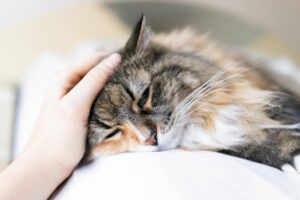 Sneezing is a common symptom of upper respiratory infections (URIs) in cats. Often referred to as the “common cold” or the “cat flu”, upper respiratory infections can be viral, bacterial and even fungal, although that’s less common.
Sneezing is a common symptom of upper respiratory infections (URIs) in cats. Often referred to as the “common cold” or the “cat flu”, upper respiratory infections can be viral, bacterial and even fungal, although that’s less common.
These types of infections can last anywhere from 7 to 21 days, with 7 to 10 days as the average duration for uncomplicated cases.
Symptoms
Common symptoms of upper respiratory infection in cats include:
- Recurring sneezing over several hours or days
- Unusual discharge from the nose or eyes that can appear clear, yellow, green or bloody
- Repeated coughing or swallowing
- Lethargy or fever
- Dehydration and/or decreased appetite
Cats at a higher risk of developing URIs include kittens and elderly cats, as well as unvaccinated and immunosuppressed cats. Since many of the viruses that cause these infections are highly contagious, those kept in groups such as shelters and multicat households are also vulnerable, especially if they’re unvaccinated.
Treatment
Treatment for upper respiratory infections depends on the severity. In cases with generally mild symptoms, URIs can resolve on their own after a couple of weeks. In other cases, additional treatment may be required, such as:
- Antiviral medications or antibiotics
- Eye and/or nose drops
- Steroids
- Subcutaneous fluids (in cases involving dehydration)
Severe cases may require hospitalization for more intensive treatment such as IV fluids and nutritional support. If left untreated, upper respiratory infections can lead to other serious complications such as pneumonia, chronic breathing issues and even blindness.
If you do suspect your cat has an upper respiratory infection, here are some immediate steps you can take to offer some relief:
- Regularly clean any discharge from your cat’s nose and face with warm, moist cotton.
- Try to get your cat to eat by warming up some canned food.
- Make sure your cat has plenty of fresh water.
- Run a humidifier to help keep your cat’s nasal passages moist.
Nasal and Sinus Issues
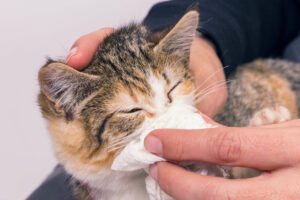 Cats can also suffer from inflammatory conditions like rhinitis and sinusitis. Rhinitis is the inflammation of the mucous membranes of the nose, which we all know as a “stuffy nose”, and sinusitis is inflammation in the lining of the sinuses.
Cats can also suffer from inflammatory conditions like rhinitis and sinusitis. Rhinitis is the inflammation of the mucous membranes of the nose, which we all know as a “stuffy nose”, and sinusitis is inflammation in the lining of the sinuses.
These two conditions often occur together in cats, termed “rhinosinusitis”, and are common complications of upper respiratory infections.
Symptoms
In addition to frequent sneezing, signs of rhinitis and sinusitis in cats include:
- Clear nasal discharge in mild cases OR yellow, green or bloody in severe cases
- Labored breathing, snoring and/or breathing through the mouth
- Pawing at the face
- Tearing and discharge from the eyes
- Reverse sneezing (clearing the nose through short, rapid inhalations)
- A lump on the bridge of the nose (if fungal)
Treatment
Diagnosing rhinitis and sinusitis involves an evaluation of your cat’s medical history, along with a thorough physical examination. A rhinoscopy, which involves inserting a small endoscope into the nose or mouth for better visualization of the nasal structure, may also be needed along with a nasal wash to collect samples.
Treatment may include a nasal flush and broad-spectrum antibiotics to treat or prevent bacterial infections, along with a dose of steroids to open up the nasal and sinus cavities. Intravenous fluids and nutritional support may also be needed in severe cases.
Chronic Upper Respiratory Conditions
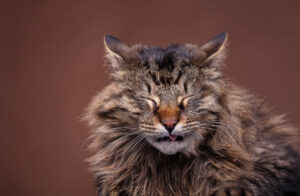 Frequent and recurring sneezing in cats can also be due to chronic respiratory conditions. Chronic rhinitis is the most common and is usually the result of permanent damage to the immune system and nasal passages.
Frequent and recurring sneezing in cats can also be due to chronic respiratory conditions. Chronic rhinitis is the most common and is usually the result of permanent damage to the immune system and nasal passages.
Symptoms
The symptoms of chronic upper respiratory conditions in cats are similar to upper respiratory infections and inflammation, but persist over weeks or months or in intervals of a few weeks. Conditions like chronic rhinitis can also lead to recurring bacterial infections, which can worsen the symptoms.
These symptoms may include:
- Sneezing fits
- Stuffy, runny nose
- Thick, yellow nasal discharge
- Loss of appetite
- Drooling and difficulty swallowing
- Discharge from one or both eyes
Cats that have already recovered from severe acute viral infections, such as feline calicivirus and feline herpesvirus, are more susceptible to chronic upper respiratory conditions, with symptoms persisting continuously or intermittently. They are also more likely to suffer from virus reactivation due to stress, illness, or immunosuppression.
Treatment Options
With chronic conditions, further investigation is needed to determine the underlying causes, including:
- Blood and urine tests to detect viruses and other infectious diseases
- X-rays or advanced imaging (CT or MRI) of the nose, pharynx and chest
- Rhinoscopy for better visualization of the structures within the nose
- Small biopsies from the nose to determine if any organisms are present
Unfortunately, there are no cures for chronic upper respiratory conditions in cats, therefore, treatment usually involves managing the symptoms with frequent veterinary care and medications.
Allergies
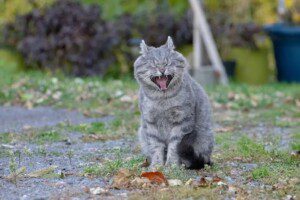 Unlike in humans, allergies are not a common cause of sneezing in cats. Instead, symptoms usually appear in the form of skin irritations, such as lesions, itchiness and hair loss. However, some cats can suffer from other symptoms, such as itchy and watery eyes along with coughing, sneezing and wheezing – particularly in cats with asthma.
Unlike in humans, allergies are not a common cause of sneezing in cats. Instead, symptoms usually appear in the form of skin irritations, such as lesions, itchiness and hair loss. However, some cats can suffer from other symptoms, such as itchy and watery eyes along with coughing, sneezing and wheezing – particularly in cats with asthma.
This condition, known as “hay fever” in humans, is called allergic rhinitis and symptoms can occur seasonally if due to outdoor allergens like pollen, or year-round if caused by indoor allergens such as dust and mold.
Treatment Options
Unfortunately, there are no cures for allergies in cats. However, the symptoms can be managed with a specialized treatment plan developed by your primary veterinarian or a veterinary dermatology specialist. This may include customized vaccines and other medications, along with a special diet.
Vaccines
Certain vaccines, like those used to prevent upper respiratory infections, may also cause sneezing in cats. However, symptoms usually resolve on their own within a few days.
Fight the Cold Before It Happens
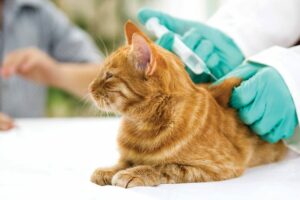
Of course, prevention is always better than treatment. By taking a few extra steps, you might be able to keep your cat healthy and avoid a lifetime of sneezing.
One of the best ways to prevent certain viruses is by having your cat vaccinated according to the schedule recommended by your family veterinarian. If you’re ever unsure about any aspect of your cat’s health, call your family veterinarian. That’s what the doctor’s for!

